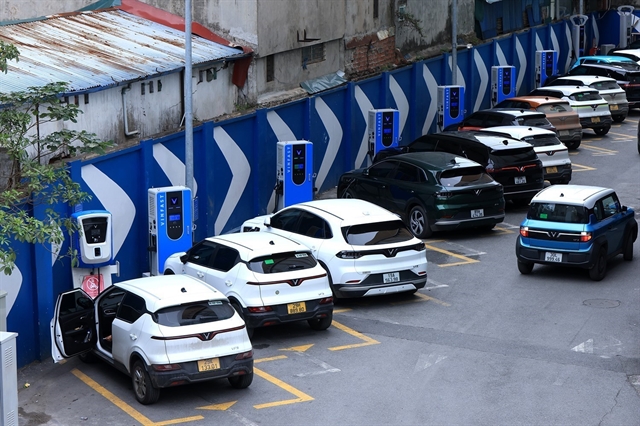 Society
Society

Compiled by Lê Việt Dũng

|
| A charging station for electric cars on Phạm Ngọc Thạch Street, Hà Nội. — VNA/VNS Photo |
HÀ NỘI — Hà Nội is set to implement a sweeping ban on fossil fuel-powered motorcycles to reduce air pollution and ease chronic traffic congestion.
This new initiative will be rolled out in stages, starting in 2026. The long-term goal is to transition Hà Nội into a greener city by drastically cutting emissions from transportation.
The backbone of this ambitious policy is Directive 20, which was issued on July 12. It specifies a series of urgent tasks to curb air pollution, which has reached alarmingly high levels in the capital.
The directive outlines a phased approach to banning fossil fuel-powered motorcycles, gradually expanding the scope of the ban across the city.
The overarching objective is to significantly reduce traffic-related emissions, improve air quality and ease congestion. By the time the full policy is implemented, the city will transition to cleaner energy vehicles, with the ultimate goal of becoming a zero-emissions city by 2050.
The motorcycle ban will be enforced over several stages, beginning with a pilot period and culminating in a citywide restriction. Here's a breakdown of the timeline:
• Pilot Phase (January-July 2026): Hà Nội will begin limiting petrol-powered motorcycles in certain urban areas. This phase will serve as a test period, allowing the city to assess the policy's effect and gather feedback before proceeding with broader enforcement.
• Phase 1 (From July 2026): A full ban on all fossil fuel-powered motorcycles will come into effect in the area inside Ring Road 1, which includes major streets such as Trần Khát Chân, Đại Cồ Việt and Đê La Thành. This will be the first area to experience the full scope of the policy.
• Phase 2 (From January 2028): The ban will extend to the entire area inside Ring Road 2, covering a wider swath of Hà Nội. This phase will also see restrictions on personal cars powered by fossil fuels within both Ring Roads 1 and 2.
• Phase 3 (From 2030): The final phase will extend the restrictions to all vehicles using fossil fuels, including motorcycles and cars, within the area bounded by Ring Road 3.
Hà Nội’s long-term plan aims for a complete transition to electric vehicles (EVs) and other clean energy alternatives by 2050. This will include phasing out hybrid and compressed natural gas vehicles, making the city’s transportation sector fully green.
The roadmap set out by the Government is in line with Việt Nam’s commitment to achieving net-zero emissions by 2050, positioning Hà Nội as a leader in the country's drive towards sustainability.
Why the ban is necessary
Hà Nội faces a significant air pollution crisis, with the city regularly ranking among the most polluted cities in the world. Reports show that traffic is responsible for up to three-quarters of Hà Nội’s total air pollution, with motorcycles being one of the largest sources of emissions.
The city currently has around 6.9 million registered motorcycles, many of which are old and poorly maintained. As much as 72 per cent of these motorcycles are considered 'high polluters', making them a major target for the city's new policy.
In addition to air pollution, Hà Nội struggles with severe traffic congestion. The city’s roads are often clogged with traffic, particularly in the central wards. The Ring Road 1 area sees traffic volumes of up to 1.3 million vehicles daily, which causes massive bottlenecks at key intersections. By removing the most polluting vehicles from the roads, the city hopes to alleviate congestion and improve the overall flow of traffic.
To ensure that the motorcycle ban is successfully implemented, Hà Nội will introduce a range of enforcement measures. The city will install clear signage around the restricted areas, marking the boundaries of the no-go zones with visible 'motorcycle prohibited' signs.
Traffic police will be deployed at key intersections to monitor violations and manage traffic flow.
During the initial phase, enforcement will focus on education and warnings. However, once the policy is in full swing, violators will face fines that could range from VNĐ2,000,000 to VNĐ3,00,000 (US$76-115) for entering restricted zones.
Additionally, the city plans to install surveillance cameras at strategic points throughout the city to detect and fine offenders remotely. The use of this technology is designed to ensure that the ban is enforced consistently and fairly.
Financial support
One of the challenges of this transition will be the financial burden on residents, particularly those who own petrol-powered motorcycles. To mitigate this, Hà Nội is proposing several financial support measures to ease the shift towards EVs.
These measures are expected to be discussed and approved in September 2025. The proposal includes cash subsidies for individuals who exchange their petrol motorcycles for electric ones, as well as exemptions from registration and licence plate fees for EVs.
The cash subsidies are structured in different tiers: VNĐ3 million ($115) for regular individuals, VNĐ4 million ($150) for near-poor households and VNĐ5 million ($190) for poor households.
However, these subsidies come with certain conditions: residents must own a petrol or diesel motorcycle (registered before the resolution takes effect) in low-emission zones and they must convert it to a green vehicle worth at least VNĐ15 million ($570).
"Hà Nội will provide maximum support to the right groups, ensuring that its residents and those who frequently travel into the Ring Road 1 area will benefit from these changes," stated Dương Đức Tuấn, Vice Chairman of Hà Nội People’s Committee.
Each individual can only receive this financial support once for one vehicle, with the policy running through to 2030.
The city is also considering proposals from Vingroup, which has put forward financing options for residents looking to purchase EVs, including instalment loan packages with low-interest rates ranging from 3 to 5 per cent annually to make the transition to EVs more affordable.
Additionally, the city plans to roll out a series of other incentives, including subsidies for businesses investing in charging station infrastructure. They will receive up to 70 per cent interest rate support for the first five years, and projects that include parking lots with at least 30 per cent charging spots will receive 50 per cent support for land clearance costs, as well as 100 per cent of land rental fees for five years.
Businesses in passenger transport and freight and those involved in the recycling and refurbishment of old vehicles will also be eligible for preferential loans with interest rates ranging from 3 per cent to 5 per cent annually, with loan terms of up to five years.
Hà Nội is also strongly encouraging private investors to participate in the development of clean energy transport infrastructure through public-private partnerships. Investors will receive priority for land allocation and will be supported with 100 per cent land rental subsidies for development in designated areas until 2033.
The goal is to make it easier for residents and businesses to make the switch to green vehicles, ensuring that the infrastructure to support EVs is in place before the restrictions are fully implemented.
Infrastructure for EVs
An essential part of Hà Nội’s green transition is the development of a robust electric vehicle infrastructure. Currently, the city’s charging network is underdeveloped and unable to meet the growing demand.
To address this, the city plans to expand the number of charging stations across key areas, including high-density residential neighbourhoods and major transport corridors.
By the end of 2026, at least 30 per cent of parking spaces in new construction projects and 10 per cent in existing buildings will be required to be equipped with charging stations.
Hà Nội is also working to establish clear standards for charging stations to ensure interoperability across different types of EVs. The city has identified strategic locations along Ring Road 1 for the installation of public parking lots with integrated charging stations.
These new stations will be vital in supporting the growing number of EVs on the road.
Hà Nội is not the first city to embark on such a bold plan. Guangzhou in China implemented a ban on motorcycles in 2006, which was expanded to the entire city centre the following year. The city replaced motorcycles with electric buses on narrow streets, helping to improve air quality and reduce congestion.
European cities, such as Paris and London, are also taking steps towards eliminating fossil-fuel-powered vehicles, but with more gradual approaches.
For example, Paris plans to ban petrol cars by 2030 and has already started restricting diesel vehicles. London, on the other hand, has introduced a Ultra Low Emission Zone in which non-compliant vehicles are charged a daily fee to enter the city centre.
Hà Nội’s transition to a zero-emissions city, while challenging, represents a significant step towards addressing the pressing environmental challenges of the 21st century.
By targeting the most polluting vehicles, providing financial support for residents and businesses and investing in green infrastructure, the city hopes to create a cleaner urban environment for its residents. VNS